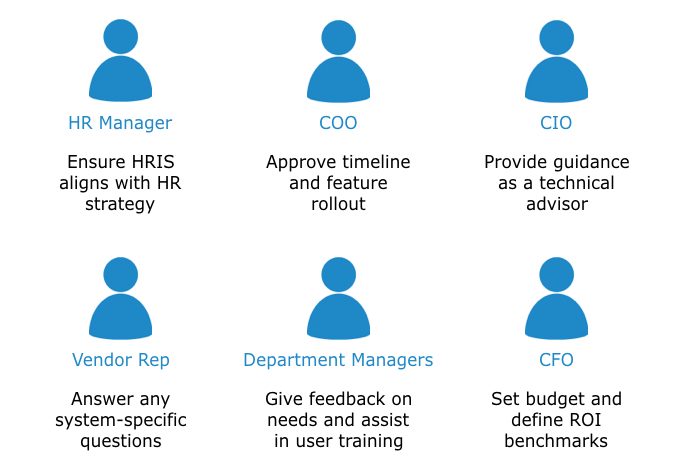4 Tips for Managing the People in Your HRIS Implementation
In 1995, Alanis Morissette released the hit song “Ironic.” It’s a great song, except for the fact that nothing mentioned in the lyrics is even remotely ironic.
“It’s like rain on your wedding day.”
“It’s like ten thousand spoons, when all you need is a knife.”

That’s not ironic, Alanis. It’s just… unfortunate? Unlucky?
Here’s some actual irony: The very employees you hope to better manage with your new human resources information system (HRIS) could be the main culprits behind why your HRIS implementation ultimately fails.
That’s according to Mike Burden of Gartner, a software research and advisory firm, in the 2016 report, “HR Transformation Projects Must Address Nontechnology Issues” (content available to Gartner clients). Burden writes:
“Initiatives to transform human capital management often fail because they focus on technology and don’t address issues of project management, change management and local compliance … A new HCM application may provide new technology, but it cannot automatically change the behavioral habits of employees, including managers.”
So, before your small business decides to abandon the expensive HRIS they just purchased, read these four tips from Burden’s report. We’ll look at how to deal with the “humans” in your human resource software implementation to maximize your software’s potential.
Click on a tip to jump to that section:
Tip #1: Exercise Project Governance
Tip #2: Form a Project Steering Committee With Care
Tip #3: Put Yourself In Your Workers’ Shoes
Tip #4: Identify and Utilize Your Champions
Tip #1: Exercise Project Governance
Have you ever been invited to a potluck dinner where the instructions were kind of vague and you didn’t know what to bring, so you showed up with potato salad only to discover that everyone else had brought potato salad too?

“Great party!” said literally no one ever (Source)
Besides good taste (because potato salad is awful), these dinners also lack what’s called project governance. HRIS implementations can have this problem as well.
Project governance involves outlining everyone’s role in a project and defining each person’s responsibilities and accountabilities.
Establishing project governance ensures that:
Nothing slips through the cracks during your HRIS implementation, because every task involved in the entire process is delegated well in advance.
Team members won’t waste time doing work already covered by someone else. In other words, you’re making sure only one person brings potato salad to the party.
Perhaps most importantly, however, project governance means deciding who can make final decisions about project tasks and deliverables. This is a significant need with an HRIS implementation that involves so many different departments and stakeholders.
For example, if your HR manager knows they have final say over data migration and the customized fields in your new HRIS, they can do their tasks without running everything up a chain of command, saving valuable time.
This is also important for accountability. If data migration tasks go past their deadline, you know who’s to blame.
Tip #2: Form a Project Steering Committee With Care
Tell me if this makes sense to you:
A company spends months demoing different HRISs to find the one that best fits their organizational needs. Then, after deciding on a vendor, they spend less than five minutes deciding who will be part of the strategic team to lead its implementation.
It sounds kind of insane, right? Yet it’s a mistake that small businesses make over and over.
Having the right mix of stakeholders on your HRIS implementation project steering committee is vital to your success, so it deserves more than a second thought. Get it wrong, and you may be looking at an extended implementation timeline, or worse, an angry boss wanting to scrap the whole project and start over because they weren’t in the know.
Here are some common examples of people you may want to include and their role in the process:

If you have to choose between too few and too many, fewer people is better. Those who’ve had the stressful responsibility of deciding on a meeting time or reserving a room for a lot of people will understand why.
Unsure how to keep your big bosses in the loop on your implementation? Learn how to effectively manage and engage project stakeholders with our downloadable checklist.
Once the steering committee members have been established, Burden recommends they meet at least once a quarter “to measure the project’s progress and decide any changes to scope, resources and budget.”
Tip #3: Put Yourself in Your Workers’ Shoes
You’re ecstatic. After months of tinkering and meetings and compromise and endless back-and-forth, your new HRIS is finally ready for its rollout. It’s going to make payroll, time tracking and more so much easier for your HR department!

Pictured: You
Your employees on the other hand? Yeah, they’re not so happy.

Pictured: Them
Maybe they’re resentful that they have to learn how to use yet another tool or confused why a new system is even needed in the first place. It could also just be a simple case of apathy. They have other things on their mind after all.
A study by Project Management Institute (PMI) found that bad communication was the primary cause of project failure a third of the time and had a negative impact on project success more than half the time.
To ensure that the system is both used and liked, it’s essential to anticipate how your employees are going to react to new software. You should also shape your communication to them accordingly.
Burden offers some change management tips:
Don’t talk about strategy or vision. Most workers won’t care about that. They want to know how this new system will impact their day-to-day.
Be clear, candid and credible. Explain to workers what changes they can expect, what they will have to do differently, why and when.
Focus on how this benefits them. Your new system should allow workers to perform tasks such as requesting time off and updating their insurance faster and with more flexibility.
Use the word “important” sparingly. “Recognize that if you call everything important, it’s likely that nothing will be done well,” Burden says.
Extend beyond the launch period. Update affected workers as changes are made and features are rolled out.
Lastly, make sure to implement some sort of system so workers can provide feedback. This can be in the form of a suggestion box, a contact email or an online survey.
Tip #4: Identify and Utilize Your Champions
The bandwagon effect is a powerful thing. It can cause a “FOMO” epidemic on social media and convince otherwise smart people to choose an obviously wrong answer, simply because they saw others choose it first.
If your mom ever asked if you’d jump off a bridge just because all of your friends did, the bandwagon effect says you might.

You can use this phenomenon to your advantage during your HRIS implementation to encourage continuous adoption and engagement with a new system. Burden explains:
“The power of social sharing within an organization can greatly increase uptake of new HCM technology … The implications of changes to HR processes and technologies may differ by staff group, but a strong superuser community enables empathy across groups, which helps the technologies remain effective after implementation.”
Once your new software is in the hands of its intended audience, identify a few “superusers” in different departments to act as allies and champions of your cause. They should be well-trained on the system to act as points of contact outside HR for any system questions or concerns from co-workers.
Superusers can be proactive by providing recommendations to the project steering committee for future updates and rollouts. They can lead individual training sessions and even set aside time for experimentation. (Have your workers play around with the system for half an hour with no goals in mind, and you’ll be surprised how fast they take to it.)
Some Last Bits of Advice
Alanis may have been way off-base on irony, but she pretty much nailed it in her 2006 song, “Crazy”:
“In a world full of people, only some want to fly.”
You hope that everyone will share your vision and optimism for a new HR system, but the reality is there are always going to be conflicting opinions and naysayers.
It’s up to you to choose the perfect system and to make the best case for adoption in the first place. You must remain steadfast in your commitment to see the software’s implementation through to a successful end.
Here are some last bits of advice:
Find ways to streamline HR service delivery. If employees are constantly emailing questions or complaining of slow turnaround on requests, introduces ways to streamline HR service delivery with your new system. We offer three best practices here.
Know when it’s time to throw in the towel. If your new system continuously falls short of business requirements, increases costs or causes widespread headaches, it could simply be a poor fit. Head to our HR software page to better research and compare new options.